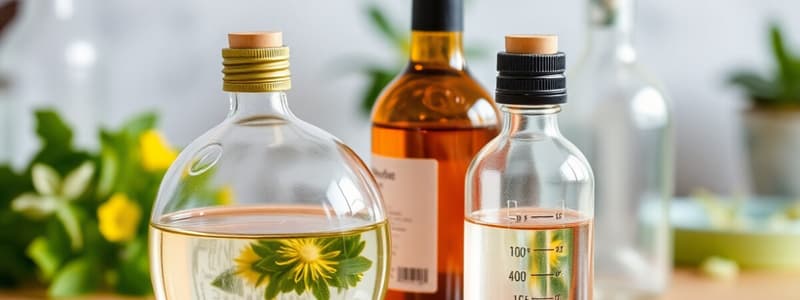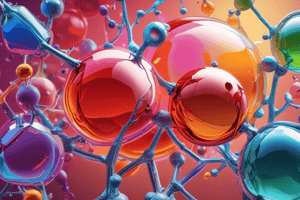Podcast
Questions and Answers
What is the general formula for alcohols?
What is the general formula for alcohols?
- C – OH
- R – OH (correct)
- R – O – R'
- R – O$H_2$
Which of the following statements about phenols is true?
Which of the following statements about phenols is true?
- Phenols do not exhibit acidity.
- Phenols can be converted directly into ethers.
- Phenols are alcohols without any aromatic characteristics.
- Phenols contain a hydroxyl group attached to a carbon that is part of an aromatic ring. (correct)
Which reaction is typically associated with ethers?
Which reaction is typically associated with ethers?
- Ethers can be easily hydrolyzed in acid.
- Ethers are synthesized through dehydration of alcohols. (correct)
- Ethers do not participate in substitution reactions.
- Ethers undergo oxidation to form alcohols.
Which property differentiates phenols from alcohols?
Which property differentiates phenols from alcohols?
What best describes the function of the R group in the alcohol structure?
What best describes the function of the R group in the alcohol structure?
Flashcards
Alcohol
Alcohol
A functional group containing a hydroxyl group (-OH) bonded to a saturated carbon atom.
Phenol
Phenol
A type of alcohol where the hydroxyl group is attached to an aromatic ring.
Ether
Ether
A functional group consisting of an oxygen atom bonded to two alkyl or aryl groups.
Esterification
Esterification
Signup and view all the flashcards
Alkyl Halide Formation
Alkyl Halide Formation
Signup and view all the flashcards
Study Notes
Alcohols, Phenols, and Ethers Summary
- This lecture covers reactions and preparations of alcohols, phenols, and ethers, focused on JEE 2025 syllabus.
Reactions of Alcohol
-
Oxidation: Alcohols can be oxidized to aldehydes, ketones, or carboxylic acids using reagents like KMnO₄, K₂Cr₂O₇, Jones reagent, PCC, PDC, and CrO₃/Acetone. The specific outcome depends on the type of alcohol (primary, secondary, tertiary) and the oxidizing agent.
-
Dehydration: Alcohols can be dehydrated to alkenes using concentrated sulfuric acid (H₂SO₄) at high temperatures. This process involves removing a water molecule.
-
Esterification: Alcohols can react with carboxylic acids to form esters in the presence of acid catalysts (e.g., H⁺).
Reactions of Phenol
-
Nitration: Phenol can be nitrated using a mixture of concentrated sulfuric acid (H₂SO₄) and nitric acid (HNO₃) to form nitrophenols.
-
Halogenation: Halogenation may happen via electrophilic aromatic substitution. Bromine (Br₂) or chlorine (Cl₂) will react in a certain controlled environment to add halogens in the presence of Lewis Acid.
-
Reimer-Tiemann Reaction: Reaction with chloroform (CHCl₃) and a base (NaOH) to introduce a formyl group (CHO).
-
Kolbe's reaction: Reaction of a phenoxide ion with carbon dioxide (CO₂)
Reactions of Ether
- Cleavage: Ethers can be cleaved using strong acids (e.g., HI, HBr) or H₂O₂ with certain metal ions to produce alcohols or alkyl halides.
Preparation of Alcohols
-
Reduction of Aldehydes and Ketones: Aldehydes and ketones can be reduced to alcohols using reagents like LiAlH₄, NaBH₄, or DIBAL-H.
-
Grignard Reagents: Grignard reagents (RMgX) can be used to form alcohol in reaction with aldehydes and ketones.
- Alkyl halides react with Mg in an ether to form Grignard reagents. These will then react with a variety of carbonyl compounds (aldehydes or ketones) to form alcohol that can be hydrolyzed to form the desired alcohol intermediate.
- Reactions with formaldehydes lead to primary alcohol
- Reactions with ketones lead to secondary alcohol
Preparation of Ethers
- Williamson Ether Synthesis: Alkyl halides react with sodium alkoxides (RONa) in dry conditions to produce ethers.
Preparation of Phenol
-
Dow's process: Chlorobenzene is treated with NaOH/CO₂ to produce phenol.
-
Cumene process: Cumene reacts with oxygen (O₂) and then is treated with water (H₂O) then acid to produce phenol.
Reduction Reactions
- Many are possible, including reduction of alkyl halides, aldehydes, ketones, etc. Different methods may result in distinct alcohols (by primary, secondary, or tertiary classifications).
Studying That Suits You
Use AI to generate personalized quizzes and flashcards to suit your learning preferences.




